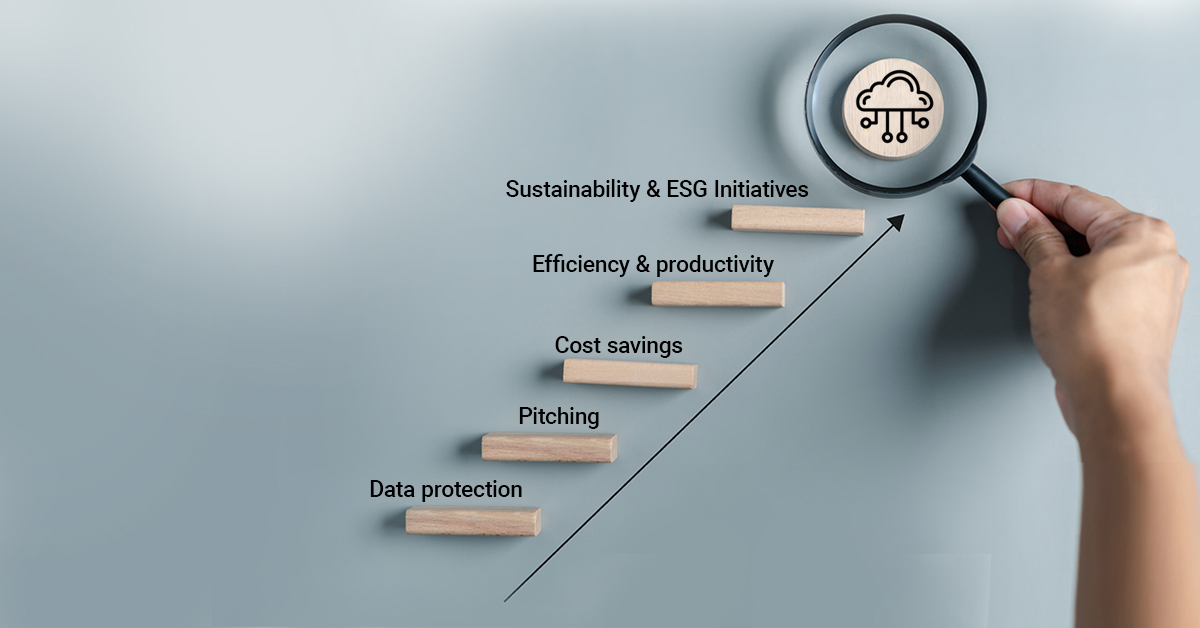A global recession, geopolitical turmoil and a continuing talent shortage: these are the risks that procurement teams are dealing with now and will deal with for the foreseeable future. All told, it means doing more with less, in terms of both capital and personnel.
To cope, an increasing number of businesses are turning to procurement technology. Hackett Group is projecting a 5.7% increase in spending in this area. So why do businesses think that investing in procurement technology is the answer? How can it help them achieve more with less? Let’s take a look.
Top 5 Reasons for Investment in Procurement Technology
Sustainability & ESG Initiatives
It may seem that, in a world squeezed by inflation, political tension and a talent shortage, sustainability initiatives are a luxury. That’s simply not the case. Perhaps counter-intuitively, ESG initiatives are driving businesses forward by opening up new markets and providing strategic opportunities.
On top of this, sustainability is a legal requirement in industries that deal closely with contaminants or cheap labour. It’s imperative that businesses operating in these industries do everything they can to reduce emissions, reuse and recycle and work with ethical suppliers.
Cutting-edge procurement technology enables businesses to track their suppliers’ sustainability practices, as well as vet potential vendors. It can also help organisations turn the spotlight inwards and detect areas within their own operations ripe for a sustainability overhaul. There’s also blockchain technology, which can track the origin and lifecycle of products and materials.
Overall, this type of technology can help organisations keep track of their ESG initiatives, which allows them to demonstrate their bona fides and keep investors and stakeholders happy.
Efficiency & productivity
Purchase requisition approvals, order tracking, approval workflows, basic data entry. These mundane, time-consuming tasks are the bane of procurement workers. Necessary, but hardly strategic drivers.
With AI and machine learning, however, these tasks become automated and far more efficient. Purchase requisitions, now streamlined and digitised, enable quicker initiation, reducing lead times for acquiring essential supplies. Automated approval workflows ensure swift decision-making, eliminating bottlenecks and expediting procurement cycles. Real-time supplier communication platforms facilitate seamless collaboration, minimising errors and misunderstandings.
In short, procurement professionals are liberated from the mundane tasks that technology can do quicker and better, allowing them to focus on the strategic activities that are more engaging and potentially offer more value for their organisation.
Cost savings
Procurement has always been tasked with getting what’s needed for the best price possible. With inflation, regional instability and a scarcity of talent, this mandate has only become more important. Procurement technology helps in this regard by helping workers make the right calls faster.
By leveraging data-driven insights, AI guides smart purchasing decisions, enabling organisations to select the right suppliers and negotiate favourable terms, leading to immediate savings.
Performance evaluation, benchmarking and market analysis allow for more robust supplier negotiations, and powerful software sifts through data to pinpoint areas ripe for optimisation. Redundancies and inefficiencies are identified, offering a targeted approach to cost reduction with the potential to entirely eliminate unnecessary expenses.
Pitching
This one may seem left field, but pitching is an incredibly important part of a procurement professional’s job. After all, if they can’t convince stakeholders or the C-suite of the merits of a project, that project will never get off the ground and potential savings won’t be made.
Data is what convinces people. The problem is that this data hasn’t always been easily accessible or easily presentable. The great thing about procurement technology isn’t simply that it gives access to this data, but that it’s presented in an easily consumable fashion.
For instance, dashboards like ProcureTRAK’s Project Charters clearly lay out the information that management is most concerned with. At a glance, they’ll see:
- the complexity of the project, based on a range of factors;
- the level of stakeholder engagement;
- annual and FY savings; and
- length of time to complete, including days to consult stakeholders and days needed to complete the actual project.
This dashboard also gives another crucial piece of information. A lot of the time, the answer from C-suite isn’t quite ‘no’, but ‘I’ll have to consult…’ or ‘let me think about it’. To combat the stalling, Project Charters gives a dollar amount of lost savings for every day the project is delayed. This is precisely the information and motivation C-suite needs to see the merit in the idea.
Data protection
Cybersecurity is a hot topic, and for good reason. With several big data breaches hitting high-profile organisations over the last couple of years, everybody is a little paranoid about being tomorrow’s headline for all the wrong reasons. Procurement technology can tighten leaky ships by:
- Data Encryption: Modern procurement software uses strong encryption to protect sensitive information, making it unreadable even if intercepted.
- Access Control: Fine-grained access control limits who can view, edit or modify sensitive procurement data, ensuring authorised access.
- Audit Trails: Detailed logs track every action, aiding in the detection of unauthorised or suspicious activities and ensuring accountability.
- Compliance Management: Procurement technology checks and enforces compliance with internal policies and external regulations, reducing non-compliance risks.
- Secure Document Management: Centralised document storage reduces the risk of mishandling or loss of sensitive documents.
- Reduction of Human Error: Automation minimises human errors, decreasing the risk of data breaches.
- Enhanced Supplier Security: Procurement technology evaluates supplier stability and risk factors, reducing exposure to unstable suppliers.
It’s time to invest seriously in procurement technology
Procurement is evolving fast, and the technology that powers it is changing the way results are delivered and how stakeholders are engaged. Procurement teams that are competing for contracts without the benefit of cutting-edge technology are fighting with one hand tied behind their back.
If you want your company to start investing more heavily in procurement technology but aren’t sure where to begin, give Comprara a call today. We have the software and the expertise to guide you through the entire process in a way tailored to your objectives.



